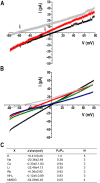Molecular and electrophysiological characterization of a novel cation channel of Trypanosoma cruzi
- PMID: 22685407
- PMCID: PMC3369953
- DOI: 10.1371/journal.ppat.1002750
Molecular and electrophysiological characterization of a novel cation channel of Trypanosoma cruzi
Abstract
We report the identification, functional expression, purification, reconstitution and electrophysiological characterization of a novel cation channel (TcCat) from Trypanosoma cruzi, the etiologic agent of Chagas disease. This channel is potassium permeable and shows inward rectification in the presence of magnesium. Western blot analyses with specific antibodies indicated that the protein is expressed in the three main life cycle stages of the parasite. Surprisingly, the parasites have the unprecedented ability to rapidly change the localization of the channel when they are exposed to different environmental stresses. TcCat rapidly translocates to the tip of the flagellum when trypomastigotes are submitted to acidic pH, to the plasma membrane when epimastigotes are submitted to hyperosmotic stress, and to the cell surface when amastigotes are released to the extracellular medium. Pharmacological block of TcCat activity also resulted in alterations in the trypomastigotes ability to respond to hyperosmotic stress. We also demonstrate the feasibility of purifying and reconstituting a functional ion channel from T. cruzi after recombinant expression in bacteria. The peculiar characteristics of TcCat could be important for the development of specific inhibitors with therapeutic potential against trypanosomes.
Conflict of interest statement
The authors have declared that no competing interests exist.
Figures







Similar articles
-
A Novel Calcium-Activated Potassium Channel Controls Membrane Potential and Intracellular pH in Trypanosoma cruzi.Front Cell Infect Microbiol. 2020 Jan 15;9:464. doi: 10.3389/fcimb.2019.00464. eCollection 2019. Front Cell Infect Microbiol. 2020. PMID: 32010643 Free PMC article.
-
Electrophysiological characterization of potassium conductive pathways in Trypanosoma cruzi.J Cell Biochem. 2011 Apr;112(4):1093-102. doi: 10.1002/jcb.23023. J Cell Biochem. 2011. PMID: 21308738
-
Identification and electrophysiological properties of a sphingosine-dependent plasma membrane Ca2+ channel in Trypanosoma cruzi.FEBS J. 2019 Oct;286(19):3909-3925. doi: 10.1111/febs.14947. Epub 2019 Jun 28. FEBS J. 2019. PMID: 31162791
-
Proton and sodium pumps regulate the plasma membrane potential of different stages of Trypanosoma cruzi.Mol Biochem Parasitol. 2002 Mar;120(1):127-39. doi: 10.1016/s0166-6851(01)00444-3. Mol Biochem Parasitol. 2002. PMID: 11849712
-
Molecular mimicry between Trypanosoma cruzi and host nervous tissues.Acta Cient Venez. 1992;43(6):330-40. Acta Cient Venez. 1992. PMID: 1343745 Review.
Cited by
-
New insights into roles of acidocalcisomes and contractile vacuole complex in osmoregulation in protists.Int Rev Cell Mol Biol. 2013;305:69-113. doi: 10.1016/B978-0-12-407695-2.00002-0. Int Rev Cell Mol Biol. 2013. PMID: 23890380 Free PMC article. Review.
-
Unusual features and localization of the membrane kinome of Trypanosoma brucei.PLoS One. 2021 Oct 15;16(10):e0258814. doi: 10.1371/journal.pone.0258814. eCollection 2021. PLoS One. 2021. PMID: 34653230 Free PMC article.
-
Proximity-Dependent Biotinylation and Identification of Flagellar Proteins in Trypanosoma cruzi.mSphere. 2023 Jun 22;8(3):e0008823. doi: 10.1128/msphere.00088-23. Epub 2023 Apr 5. mSphere. 2023. PMID: 37017578 Free PMC article.
-
Sialic Acid Glycobiology Unveils Trypanosoma cruzi Trypomastigote Membrane Physiology.PLoS Pathog. 2016 Apr 8;12(4):e1005559. doi: 10.1371/journal.ppat.1005559. eCollection 2016 Apr. PLoS Pathog. 2016. PMID: 27058585 Free PMC article.
-
Flagellar membrane proteins in kinetoplastid parasites.IUBMB Life. 2015 Sep;67(9):668-76. doi: 10.1002/iub.1411. Epub 2015 Aug 25. IUBMB Life. 2015. PMID: 26599841 Free PMC article. Review.
References
-
- Bern C, Montgomery SP, Herwaldt BL, Rassi A, Jr, Marin-Neto JA, et al. Evaluation and treatment of chagas disease in the United States: a systematic review. JAMA. 2007;298:2171–2181. - PubMed
-
- Milei J, Guerri-Guttenberg RA, Grana DR, Storino R. Prognostic impact of Chagas disease in the United States. Am Heart J. 2009;157:22–29. - PubMed
-
- Kollien AH, Grospietsch T, Kleffmann T, Zerbst-Boroffka I, Schaub GA. Ionic composition of the rectal contents and excreta of the reduviid bug Triatoma infestans. J Insect Physiol. 2001;47:739–747. - PubMed
-
- Van Der Heyden N, Docampo R. Intracellular pH in mammalian stages of Trypanosoma cruzi is K+-dependent and regulated by H+-ATPases. Mol Biochem Parasitol. 2000;105:237–251. - PubMed
Publication types
MeSH terms
Substances
Grants and funding
LinkOut - more resources
Full Text Sources

